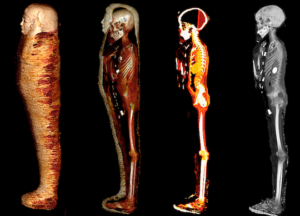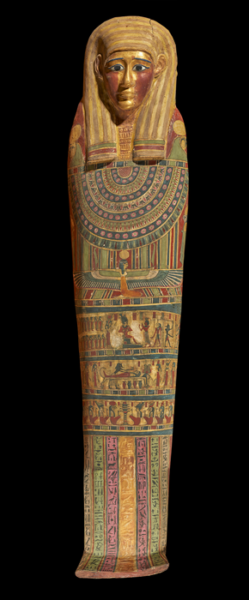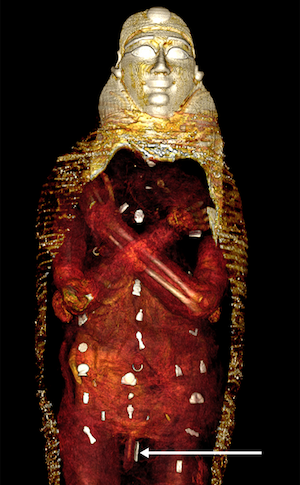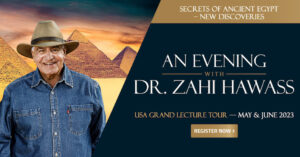
FRONTIERS—Scientists used CT scans to ‘digitally unwrap’ the approximately 2,300-year-old undisturbed mummy of a teenage boy of high socioeconomic status. The body was equipped with 49 amulets of 21 different types, many of which were made of gold, which had been carefully placed on or inside the body. These included a two-finger amulet next to the uncircumcised penis, a golden heart scarab placed inside the thoracic cavity, and a golden tongue inside the mouth. He was clad in sandals and garlanded with ferns, with ritual significance. This mummy is a showcase of Egyptian beliefs about death and the afterlife during the Ptolemaic period.
Main text: The ancient Egyptians believed that when we died, our spiritual body sought out an afterlife similar to this world. But entry into this afterlife wasn’t guaranteed: it first required a perilous journey through the underworld, followed by an individual last judgment. For this reason, relatives and embalmers did everything they could to ensure that their loved one might reach a happy destination.

The mummy’s coffin. SN Saleem, SA Seddik, M el-Halwagy
Here, scientists from Egypt used computerized tomography (CT) to ‘digitally unwrap’ the intact, never-opened mummy of a 2,300-year-old teenage boy of high socioeconomic status. They found that this ‘Golden boy’ is an undisturbed showcase of ancient Egyptian beliefs about life after death. For example, he was sent on his way with no fewer than 49 amulets of 21 types to promote his bodily resurrection. He wore sandals and was garlanded with ferns, rich in ritual meaning. These results provide a unique insight into mummification procedures and beliefs about the importance of grave ornaments during the Ptolemaic period. They are published in Frontiers in Medicine.
“Here we show that this mummy’s body was extensively decorated with 49 amulets, beautifully stylized in a unique arrangement of three columns between the folds of the wrappings and inside the mummy’s body cavity. These include the Eye of Horus, the scarab, the akhet amulet of the horizon, the placenta, the Knot of Isis, and others. Many were made of gold, while some were made of semiprecious stones, fired clay, or faience. Their purpose was to protect the body and give it vitality in the afterlife,” said Dr Sahar Saleem, the study’s first author and a professor at the Faculty of Medicine of Cairo University, Egypt.
Sandals to walk to the afterlife
The ’Golden boy’ mummy had been found in 1916 at a cemetery used between approximately 332 and 30 BCE in Nag el-Hassay in southern Egypt. It has been stored unexamined in the basement of the Egyptian Museum in Cairo until the present study.
The mummy was laid inside two coffins, an outer coffin with a Greek inscription and an inner wooden sarcophagus. Within, he wore a gilded head mask, a pectoral cartonnage that covered the front of the torso, and a pair of sandals. Apart from the heart, the viscera had been removed through an incision, while the brain had been removed through the nose and replaced with resin.
“The sandals were probably meant to enable the boy to walk out of the coffin. According to the ancient Egyptians’ ritual Book of The Dead, the deceased had to wear white sandals to be pious and clean before reciting its verses,” said Saleem.
No wisdom teeth

Amulets were placed on or inside the mummy in three columns. SN Saleem, SA Seddik, M el-Halwagy
The CT scans showed that the boy was 128 cm tall, not circumcised, and without any known cause of death other than natural causes. From the degree of bone fusion and the non-erupted wisdom teeth, the authors estimate that the boy was between 14 and 15 years old. His teeth were good, with no evidence of caries, tooth loss, or periodontal disease.
Ferns were garlanded around the mummy’s outer surface. “Ancient Egyptians were fascinated by plants and flowers and believed they possessed sacred and symbolic effects. Bouquets of plants and flowers were placed beside the deceased at the time of burial: this was done for example with the mummies of the New Kingdom kings Ahmose, Amenhotep I, and Ramesses the Great. The deceased was also offered plants in each visit to the dead during feasts,” said Saleem.
The amulets are a testament to a wide range of Egyptian beliefs. For example, a golden tongue leaf was placed inside the mouth to ensure the boy could speak in the afterlife, while a two-finger amulet was placed beside his penis to protect the embalming incision. An Isis Knot enlisted the power of Isis in the protection of the body, a right-angle amulet was meant to bring balance and leveling, and double falcon and ostrich plumes represented the duality of spiritual and material life. A golden scarab beetle was found placed inside the thoracic cavity, of which a copy was 3D printed by the researchers.
Scarab to silence the heart
“The heart scarab is mentioned in chapter 30 of the Book of the Dead: it was important in the afterlife during judging the deceased and weighing of the heart against the feather of the goddess Maat. The heart scarab silenced the heart on Judgement Day, so as not to bear witness against the deceased. It was placed inside the torso cavity during mummification to substitute for the heart if the body was ever deprived of this organ,” explained Saleem.
Based on these exciting results, the management of the Egyptian Museum decided to move the mummy to the main exhibition hall under the nickname ‘Golden boy’. In its new location, visitors can admire the mummy next to CT images and a 3D printed version of the heart scarab amulet, to get as close as possible to the glories of ancient Egyptian civilization.
________________________

The mummy digitally unwrapped in four stages. SN Saleem, SA Seddik, M el-Halwagy
________________________
Article Source: FRONTIERS news release.
*Scanning and 3D-printing using Computed Tomography (CT) of the ‘Golden boy’ mummy, Frontiers in Medicine, 24-Jan-2023. 10.3389/fmed.2022.1028377
________________________
Advertisement

Don’t miss out on this unforgettable evening as Dr. Hawass reveals the most closely guarded secrets of ancient Egypt and presents his groundbreaking new discoveries and latest research live on stage. As the man behind all major discoveries in Egypt over the last few decades and director of several ongoing archaeological projects, Dr. Hawass may yet surprise you with unexpected revelations that will make news across the world.





